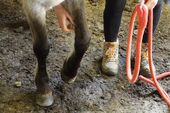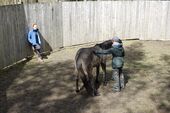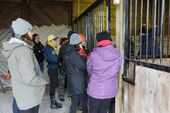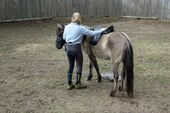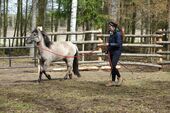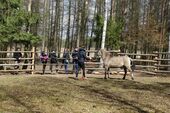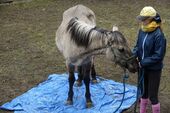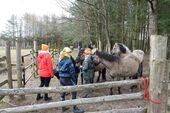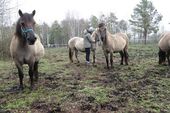 Last weekend — 22–24 April — workshops for young Polish Konik ponies took place.
Last weekend — 22–24 April — workshops for young Polish Konik ponies took place.
Just like dogs in training with a behaviorist, our ponies learned that humans are fun and worth cooperating with.
Working with ponies took place in a system of lessons of about 45 minutes twice a day. After this time the animal is clearly tired and wants to finish. Just like a student in a classroom.
What were they learning? First of all, the animals are desensitized to human touch, which means they are gently stroked starting from the head, and when they get used to it a bit, all the way to the rump.
The next tasks to be performed are moving, moving the rump, turning back and reversing — the point is to let the pony steer itself in a limited space — when we want to, e.g., examine it in the stable. At the same time, it must be safe for humans. Although not very tall (about 140 cm at the withers), they are often really wiiiide horses, with adult ones weighing 300 kg or more.
Giving a leg up and standing on the other three is a very important skill because horses have their hooves cleaned and trimmed several times a year. On soft ground, as in our peat meadows, they cannot wear them down and often their hooves are overgrown and flattened.
Later the ponies underwent real tests of bravery — overcoming a sleeping snake (a coiled rope on the ground), entering an unstable terrain, i.e., a spread sheet — for a horse it is almost an abyss!
On Sunday, which was the last, i.e., the 6th lesson, some ponies were allowed to tack up and put some weigh on them.
We were able to train 6 ponies this way. We have more workshops planned. The people who participate in the workshops and work with the ponies are volunteers who have worked with the PTOP herd before. This time Kalitnik was visited by 6 students from University of Agriculture in Krakow, 3 additional people also took part in the training by observing from behind the fence.
Ponies are herd animals and basically cannot exist alone. They are social animals and therefore very good at recognizing the emotions of other herd members by observing each other closely. If there is no other horse around, they are happy to interact with people, especially if we “speak” their language. And their language is not only neighing but also the subtle movements of the body, hooves, ears or the expression in the eyesJ. This is also what we learn during our trainings — to use one’s own body is such a way to give the animal signals how to behave with a nod of the hand, proper position of the feet, head and body.
In working with horses, we also use the right internal energy, strength to make them feel that we are in charge and gentleness to let them know that they are safe with us.

